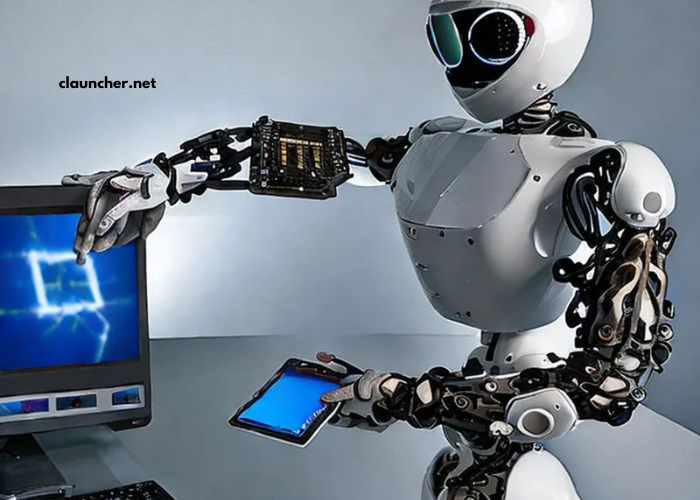
Artificial Intelligence (AI) has become a transformative force in shaping the future of technology. It is revolutionizing industries, improving efficiencies, and enhancing human capabilities. AI systems now extend far beyond theoretical research, impacting various sectors such as healthcare, finance, transportation, and entertainment. As AI continues to evolve, its influence on the technological landscape will only grow, leading to groundbreaking innovations and new ways of interacting with the world.
In this article, we explore how AI is shaping the future of technology, its current applications, and the potential opportunities and challenges it presents.
Understanding Artificial Intelligence and Its Impact
What is AI?
Artificial Intelligence refers to the simulation of human intelligence processes by machines, particularly computer systems. These processes include learning (acquiring information), reasoning (drawing conclusions), problem-solving, perception, and language understanding. AI systems are typically powered by advanced algorithms and large datasets, enabling them to make decisions, recognize patterns, and execute tasks with minimal human intervention.
There are different types of AI systems:
- Narrow AI (Weak AI): Designed to perform specific tasks such as facial recognition, speech processing, or autonomous driving.
- General AI (Strong AI): This is theoretical AI that aims to replicate human-like intelligence across all tasks, which we have not yet fully achieved.
AI’s Role in Technological Advancements
The role of AI in shaping technology is profound. It serves as the backbone for several emerging technologies, facilitating their growth and development. By automating complex tasks and enhancing human decision-making, AI has proven to be an invaluable asset across multiple domains.
Key Sectors Revolutionized by AI
1. AI in Healthcare: Improving Patient Outcomes
One of the most promising areas for AI to shape the future of technology is in healthcare. AI technologies are already playing an instrumental role in the diagnosis, treatment, and management of diseases.
AI-Powered Diagnostics
AI algorithms can analyze medical data, including X-rays, MRIs, and CT scans, to identify patterns that may be too subtle for human eyes to detect. These systems can help doctors diagnose conditions such as cancer, neurological disorders, and heart disease more accurately and quickly, improving early detection rates.
Personalized Medicine
With AI, healthcare providers can analyze genetic data and patient health records to offer more personalized treatment plans. By predicting individual responses to medications and therapies, AI ensures better patient outcomes and fewer side effects, leading to more efficient and effective treatment strategies.
Virtual Health Assistants
AI-driven virtual assistants, such as chatbots and automated health platforms, help provide patients with immediate medical advice and answer health-related queries. These systems offer 24/7 support and help manage minor medical issues, allowing doctors to focus on more complex cases.
2. AI in Finance: Transforming the Financial Sector
The financial industry is also being transformed by AI technologies. From risk assessment to customer service, AI offers solutions that increase efficiency and reduce human error.
AI for Fraud Detection
AI-based systems are capable of analyzing large volumes of transaction data to detect fraudulent activities. Machine learning algorithms can recognize unusual patterns in spending behavior and flag potential fraud in real-time, reducing the risk to financial institutions and their customers.
Automated Trading and Investment
AI has become an essential tool for stock market analysis and investment strategies. AI algorithms can process vast amounts of financial data to make predictions about market trends, allowing automated trading systems to make high-frequency, data-driven decisions. This helps investors gain an edge in the competitive financial markets.
Chatbots and Customer Support
Financial institutions are using AI-driven chatbots to enhance customer service. These chatbots can handle a wide range of customer inquiries, process transactions, and provide financial advice, creating more seamless interactions for clients and reducing the burden on human customer support teams.
3. AI in Transportation: Revolutionizing Mobility
The transportation sector is one of the most visible examples of how AI is reshaping technology. AI’s impact here spans from autonomous vehicles to traffic management systems, making travel safer and more efficient.
Autonomous Vehicles
One of the most exciting applications of AI in transportation is the development of self-driving cars. These vehicles use machine learning algorithms, sensor data, and real-time processing to navigate roads, recognize obstacles, and make decisions without human intervention. Major companies such as Tesla, Waymo, and Uber are leading the charge in autonomous driving technology, which has the potential to reduce accidents, ease traffic congestion, and lower transportation costs.
AI-Enhanced Traffic Management
AI is also being used to optimize traffic flow in cities. AI-powered traffic management systems can analyze real-time traffic data, adjust traffic signals, and predict congestion patterns, helping to reduce traffic jams and improve overall road safety.
4. AI in Entertainment: Changing the Way We Consume Media
AI is not limited to practical applications; it is also transforming the entertainment industry. From content recommendations to immersive experiences, AI is enhancing the way we consume media.
Content Recommendation Algorithms
Streaming platforms such as Netflix, YouTube, and Spotify use AI-powered recommendation engines to suggest content based on user preferences, viewing habits, and interactions. By analyzing vast amounts of data, these platforms can predict what content will be most appealing to individual users, creating a more personalized and engaging experience.
AI in Game Development
AI has revolutionized the gaming industry by creating more responsive and intelligent non-playable characters (NPCs), improving game design, and optimizing gameplay mechanics. In addition, AI is used in procedural content generation, where it generates dynamic, evolving environments and storylines, ensuring that games offer a unique experience each time they are played.
Virtual Reality and AI Integration
The combination of AI and virtual reality (VR) is paving the way for more immersive experiences in gaming and entertainment. AI systems help to make VR environments more dynamic and responsive to user actions, enabling lifelike interactions and environments that feel more realistic and engaging.
5. AI in Manufacturing: Streamlining Production Processes
AI is also making waves in the manufacturing sector. By optimizing production lines, improving quality control, and reducing costs, AI helps companies stay competitive in an increasingly globalized market.
Predictive Maintenance
In manufacturing, AI-powered predictive maintenance systems can analyze data from equipment sensors to predict when machines are likely to fail. By identifying potential issues before they cause downtime, manufacturers can reduce repair costs and avoid production delays.
Robotics and Automation
AI-driven robots are now performing complex assembly tasks with precision and speed. These robots can work alongside humans in collaborative environments, improving efficiency and reducing labor costs. Additionally, AI-based automation systems help optimize the scheduling and management of production lines, ensuring that resources are used effectively.
The Future of AI: Emerging Trends and Opportunities
AI and the Internet of Things (IoT)
The integration of AI and the Internet of Things (IoT) will drive the next wave of technological innovation. IoT devices, such as smart home gadgets, wearables, and industrial sensors, will generate enormous amounts of data. AI will be key in processing and analyzing this data, enabling smarter decision-making and more efficient operations across various industries.
AI and Quantum Computing
Quantum computing is expected to be another game-changer for AI. Quantum computers have the potential to solve problems much faster than classical computers, which could enhance the capabilities of AI algorithms. This synergy could lead to more powerful AI systems that can process even larger datasets and make more accurate predictions.
Ethical Considerations and AI Regulation
As AI continues to evolve, ethical considerations become increasingly important. Issues such as data privacy, algorithmic bias, and job displacement will need to be addressed through regulation and governance. Governments, organizations, and researchers must work together to establish frameworks that ensure AI technologies are developed and deployed responsibly.
AI for Sustainability
AI can also contribute to addressing global challenges such as climate change and resource depletion. AI can optimize energy consumption, improve waste management, and support sustainable agriculture by analyzing environmental data and recommending strategies for conservation and efficiency.
Conclusion
AI is undoubtedly shaping the future of technology, driving significant advancements across various industries. From healthcare to transportation, entertainment to manufacturing, AI is enabling smarter, more efficient systems and transforming the way we live and work. While the opportunities are vast, challenges such as ethical concerns and the need for regulation must be addressed to ensure the responsible development of AI technologies.
As AI continues to evolve, its influence will become even more profound, creating new possibilities and reshaping the world as we know it. It is an exciting time to witness the intersection of AI and technology, and its potential to shape the future holds endless promise.
By understanding the immense impact AI is already having and will continue to have, individuals, organizations, and governments can better prepare for the future. With the right approach, AI can unlock innovative solutions that will improve lives and lead to a more sustainable, efficient, and connected world.





